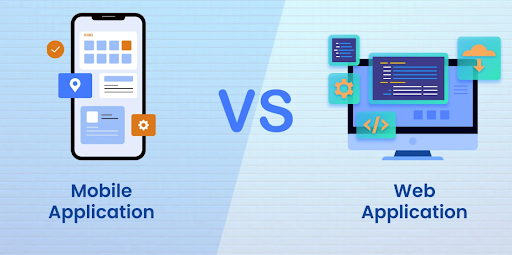We all use many daily applications for various things, such as hailing the nearest ride, ordering food, or keeping in touch with friends and family.
These apps could be mobile or web apps. Though they look similar, they function separately. Knowing the distinction between a mobile app and a web app is important, especially if you plan to build one.
This guide will walk you through the key differences, helping you choose the best of these according to your needs.
What Are Mobile Apps and Web Apps?
But before getting into the differences, let’s define what we mean by mobile apps and web apps.
Mobile Applications
Mobile applications are those which are developed for mobile devices only, meaning smartphones and tablets.
Mobile apps have to be downloaded and installed from platforms like Apple App Store and Google Play Store.
For instance, Instagram, Snapchat, or Google Maps.
Web Apps
Unlike mobile apps, web apps can be accessed through a reliable web browser and do not require downloading or installation.
Web apps are designed to look and feel like mobile apps but are built to work on any device with a browser. In other words, they are responsive to any device the user might be on, be it a smartphone, tablet, or desktop.
Some examples are web versions of services like Google Docs or Facebook.
So now that we have seen what a general mobile app or a web app is, let’s examine some of the major differences in practice.
Major Differences between Mobile Apps and Web Apps
The difference between mobile and web apps goes beyond the point of access. They contrast in development, functionality, and user experience as well. Let’s detail these:
Development Process
Let’s discuss the development process for both apps
Mobile Apps
Developing a mobile app equals writing a piece of software to run on a particular operating system.
For iOS apps, the programming languages utilized would be Swift or Objective-C, and for Android, it is generally Java or Kotlin.
Since mobile apps are platform-specific, if you really want your app to run on both iOS and Android, you have to develop two separate versions, which could take a lot of time and money.
If you want to develop a single app that runs on both iOS and Android, you can choose cross-platform development tools like Flutter, React Native, or Xamarin. This will allow you to write one codebase that works on both platforms, saving time and money while still delivering a functional app across different devices.
Web Apps
Web applications are developed using normal web technologies like HTML, CSS, and JavaScript. Since they run in a web browser, they are platform-independent, meaning the same app will run on any device, regardless of the operating system.
This makes developing a web app easier and faster than developing a mobile app since there is no central need to create various versions that will be adapted to different platforms.
Installation and Access
Below we will discuss the installation and access for both apps
Mobile Apps
Downloading and installation are prerequisites to the use of the mobile app. Installation can sometimes be a barrier as it requires adequate storage on the device and an active internet connection for download.
Web Apps
These applications do not need installation. Users can directly access them through a web browser by typing in the URL or using a bookmark.
Platforms
We’ve discussed a bit about platforms in the development process. Let’s get to know more
Mobile Apps
Mobile apps are developed exclusively for the mobile platform. They can harness the full capacity of hardware and features, including cameras, GPS, and accelerometers.
This makes them more advanced in terms of functions and performance: for example, they work offline, notify through push notifications, and easily integrate with other apps installed in the device.
Web Apps
Although web applications are in themselves cross-platform compatible, the overall user experience is comparatively weak.
Since web apps run on a browser, they don’t have an exact, thorough reach to the device’s hardware and its various features, which seriously limits their functionality. Besides, web apps are server-driven and mostly require an internet connection to work.
Maintenance and Updates
It is one of the important factors you have to consider before you develop an app for your business.
Mobile Apps
More detailed and costly issues reside in the maintenance of a mobile app. Each time an application is updated, a fresh one needs to be downloaded and installed from an application store.
Web Apps
Web apps are more easily maintained because they are updated directly on the web server. This means that users will always have the most recent version of the application without downloading anything. This kind of updating process is very smooth; it saves time and cuts down the risks of experiencing problems because of outdated software.
Time to Market and Development Cost
The time frame and your budget are extremely important for app development.
Mobile applications
Development of a mobile app can be costly, especially if you are looking to prepare apps for both iOS and Android. This means not only one-time development but further maintenance, updates, and even fees that app stores charge.
Moreover, developing a mobile app takes longer than developing other solutions because it involves coding specific to a platform and an app store approval procedure.
Web Apps
In general, web apps are cheaper to develop. Because they are platform-independent, multiples of the same app don’t need to be built.
Development can be faster, and there’s no process to be approved through the applications store, which may be a time- and money-wasting exercise in itself. The upfront cost of developing a web app will be cheaper; however, one should also consider the amount for hosting and maintenance of the web server on which it will be hosted, which can be constant.
Discoverability
Once you’ve developed your mobile or web app, the next challenge is ensuring that people can easily find it. This concept, known as discoverability, is crucial for the success of any app.
Mobile Apps
The very strength of mobile apps—being listed in app stores—can make them even stronger when users discover them.
A listing in app stores such as Google Play or Apple App Store gives exposure to a huge audience. Yet, with millions of apps in these stores, noticeability is hard but not impossible; usually, ASO (App Store Optimization) skills are put into use to enhance discoverability.
Web Apps
Web Apps, being platform-independent, are obviously not featured in any app stores, so it’s harder for users to find them.
Typically, users find Web Apps through search engines and directly via links. Thus, a large part of a Web App’s success strongly depends on search engine optimization.
Though a stretch is effective for attracting users, the same effort and resources will be required to maintain it.
Progressive Web Apps
Progressive Web Applications are relatively newcomers to the application world. They try to combine the benefits of mobile apps and web apps.
They are simply web applications that resemble mobile apps. They can be accessed through a browser or added to a user’s device’s home screen.
Advantages of PWAs
- One of the main benefits of PWAs is their ability to work offline. This is mainly due to the flexibility provided by browser technology and the features provided through them.
- PWAs could also deliver push notifications, keeping users engaged by providing information, even when the app is not currently active.
- PWAs do not require a time-consuming App Store submission process; hence, they can be launched way faster without having to wait for App Store approvals.
- Since PWAs are web-based, they do not require separate development for multiple platforms, which reduces development time and cost.
- PWAs provide a strong option for enabling businesses to offer a mobile app-like experience without incurring the high costs and complexities generally associated with native mobile app development.
On average, the cost to develop a PWA can range from $10,000 to $40,000, depending on the complexity, features, and expertise of the development team. However, the cost also depends on the location of your development team.
Developers across U.S. cities offer unique strengths that influence both cost and focus in PWA development. Los Angeles excels in creative, media-driven projects, while Chicago offers competitive pricing for industries like logistics and manufacturing.
App development companies in New York typically have higher costs comparable to a mobile app development company Houston or San Francisco, especially in tech, healthcare, and finance.
Research the companies properly and consult different app development experts to achieve a cost-effective solution that delivers a high-quality, mobile app-like experience without the complexities of traditional app development.
Pros and Cons: Mobile Apps vs. Web Apps vs. PWAs
To sum up, here is a touchy comparison of the upsides and downsides of Mobile Apps vs Web Apps vs Progressive Web Apps:
Pros And Cons Of Mobile Apps
Pros
- Faster and more responsive
- Access to device features (camera, GPS, etc.)
- Can work offline
- Push notifications
- Visibility on the App Store
Cons
- Higher development cost
- Platform dependent: need different versions for either iOS or Android
- Installation and regular updates of the apps
- Getting an app approved into the right app store is another major challenge
Pros And Cons Web Apps
Pros:
- Platform independent: can open on any device having an internet browser
- Doesn’t need installation
- Easy and fast to develop
- Updated automatically, i.e., there’s no need to wait for downloads and installations to update
- Low development cost
Cons
- Access to limited device feature
- An active internet connection is indispensable
- No native app store presence makes it tougher to be discovered
- Usually, the web would be slower and less responsive than mobile apps
Pros And Cons Of Progressive Web Apps (PWAs)
Pros
- Offline capability Push notifications
- No need for App Store approval
- Lower cost and time investment in its development
- It can be installed on a user’s home screen
Cons
- Limited access to some device features
- Not as fast and responsive as native mobile apps
- Visibility is determined by SEO, not by the app store discovery
Deciding Between a Mobile App and a Web
If you’re building an application, your first choice must be a mobile or web app.
Here are some factors to consider:
Target audience
One needs to think of who is going to use their application and their mode of accessing it. With that question in hand, if users are mainly going to access the application from a mobile device and use features of the device—for instance, a camera or its GPS location—a mobile app would be the best pick.
Budget and Resources
Building a mobile app can be quite costly, especially if two different versions are required to be developed—one for iOS and another for Android.
If one is under budget constraints, the related costs can also lead to preferring a web app or PWA to a native mobile app.
Desired Features and Functionality
Consider key features you should implement within your application. If you are targeting the specific features of the device and are aiming for a highly responsive and offline-capable experience, you may need a mobile app or PWA solution.
Time to market
If you have no time-to-market needs, the web app or PWA can be developed in a fraction of the time that a native mobile app would take. This becomes particularly important in case the work at hand has a tight deadline, or there is a need to get a minimal viable product launched quickly.
Location of Your App Development
The location of your app development team is a key factor that influences both the cost and the expertise available for your project.
For example, a company that does mobile app development in New York may be more expensive, reflecting its focus on cutting-edge innovation in sectors like finance and tech. In contrast, other locations might offer quality services at a reasonable cost, especially for industries like healthcare and education.
Similarly, Los Angeles Developers is known for its expertise in entertainment and media, while San Francisco stands out for tech innovation, particularly in Progressive Web Apps (PWAs). While offshore teams offer you cheap prices, quality may be compromised.
Long-Term Goals
Think about your goals with the app in the long term. If you are going to update the app to improve it repeatedly, the concept of updating and keeping a mobile app is much more difficult and expensive than with a web app or a PWA.
Conclusion
Understanding the differences will help you make an informed decision on the best approach for your app development project
Mobile apps are very quick in response and most feature-rich, but with high development costs and complexity. Web apps are less complex, can be developed faster, operate on any device, and do not necessitate an installation process. On the other hand, they may offer lesser optimization.
Progressive Web Apps cut a middle way that allows most of the benefits of mobile apps without associated costs and complexities.












